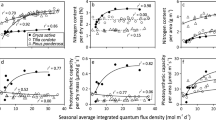Summary
The extent to which leaf-lobing influences the interception of direct solar radiation by individual plants was studied by means of computer simulations. The morphology, size and orientation ofAmbrosia artemisiifolia L. leaves were measured and used to construct a prototypeAmbrosia plant upon which a computer simulation was based. The leaf geometries of this simulation were then varied, and daily integrated irradiances (DII) were calculated for each variant plant simulation. Data indicate that lobedAmbrosia leaves do not confer an advantage to light-interception based upon values of DII. Simulated plants identical in all respects to the prototype, but with simple, elliptic leaves, had equivalent DII values to the prototype. Simulations with leaves in which gaps between lobes were “filledin” had reduced light-interception efficiencies compared to the prototype and to a simulation with elliptic-leaves. Lightinterception was maximized when leaves on distal nodes wereAmbrosia-like and leaves on proximal nodes were elliptic. The data are interpreted to indicate that lobingperse is not functionally advantageous to light-interception; however, gradients of leaf-lobing along the length of shoots may be very significant in terms of overall light interception.
Similar content being viewed by others
References
Chazdon RL (1985) Leaf display, canopy structure, and light interception of two understory palm species. Am J Bot 72:1493–1502
Chazdon RL, Fetcher N (1984) Photosynthetic light environments in a lowland tropical forest in Costa Rica. J Ecol 72:553–564
Ehleringer JR (1980) Leaf morphology and reflectance in relation to water and temperature to water and temperature stress. In: Turner N, Kramer P (eds), Adaptations of plants to water and high temperature stress, Wiley-Interscience, New York, pp 295–308
Ehleringer JR, Werk KS (1986) Modifications of solar-radiation absorption patterns and implications for carbon gain at the leaf level. In: Givnish TJ (ed), On the economy of plant form and function, Cambridge University Press, Cambridge, pp 57–82
Erickson RO, Michelini FJ (1957) The plastochron index. Am J Bot 44:297–305
Horn HS (1971) The adaptive geometry of trees. Princeton University Press, Princeton NJ
Larson PR (1980) Interrelations between phyllotaxis, leaf development and the primary-secondary vascular transition inPopulus destoides. Ann Bot 40:157–183
Lee DW (1986) Unusual strategies of light absorption in rain-forest herbs. In: Givnish TJ (ed), On the economy of plant from and function, Cambridge University Press, Cambridge, pp 105–131
Maksymowych R (1973) Analysis of leaf development. Cambridge University Press, London
Mooney HA (1972) Carbon balance of plants. Ann Rev Ecol Syst 3:315–346
Niklas KJ (1988) The role of phyllotactic pattern as a “developmental constraint” on the interception of light by leaf surfaces. Evolution 42:1–16
Niklas KJ, Boyd SP (1987) Computer program for three-dimensional reconstructions and numerical analyses of plant organs from serial sections. Am J Bot 74:1595–1599
Niklas KJ, Owens TG (1989) Physiological and morphological modifications ofPlantago major (Plantaginaceae) in response to light conditions. Am J Bot 76:370–382
Nobel PS (1980) Interception of photosynthetically active radiation by cacti of different morphology. Oecologia 45:160–166
Nobel PS (1983) Biophysical plant physiology and ecology. W.H. Freeman, San Francisco
Nobel PS (1986) Form and orientation in relation to PAR interception by cacto and agave. In: Givnish TJ (ed), On the economy of plant form and function, Cambridge University Press, Cambridge, pp 83–103
Parkhurst D, Loucks O (1972) Optimal leaf size in relation to environment. J Ecol 60:505–537
Vogel S (1968) “Sun leaves” and “shade leaves”: differences in convective heat dissipation. Ecology 49:1203–1204
Vogel S (1970) Convective cooling at low airspeeds and the shapes of broad leaves. J Exp Bot 21:91–101
Author information
Authors and Affiliations
Rights and permissions
About this article
Cite this article
Niklas, K.J. The effect of leaf-lobing on the interception of direct solar radiation. Oecologia 80, 59–64 (1989). https://doi.org/10.1007/BF00789932
Received:
Published:
Issue Date:
DOI: https://doi.org/10.1007/BF00789932




